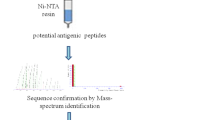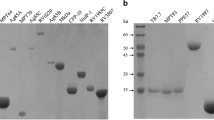Abstract
The phospholipid-associated protein (55–67 kDa) fraction of Mycobacterium tuberculosis H37Rv was purified as the DE-V protein fraction. This DE-V fraction was used for diagnosis of tuberculosis by enzyme-linked immunosorbent assay (ELISA), detecting IgG antibody in sera collected from different categories of tuberculosis patients, i.e. with acid fast bacilli (AFB) culture-positive pulmonary tuberculosis, with AFB culture-negative, but radiologically suspected, pulmonary tuberculosis, extrapulmonary tuberculosis, and control groups of patients suffering from diseases other than tuberculosis (asthma and/or rhinitis, lepromatous leprosy) as well as from healthy volunteers. Encouraging operational ELISA validity could be achieved with 93% sensitivity, 100% specificity, 97% efficiency, 100% positive predictivity and 95% negative predictability even among the extrapulmonary and suspected pulmonary tuberculosis patients. The above assay was insensitive but with 100% specificity among control group of patients suffering from diseases other than tuberculosis. The DE-V protein fraction was associated with phosphatidyl inositol and phosphatidyl inositol mannosides. The dissociation of phospholipid-protein complex decreased ELISA specificity. ELISA reactivity of the DE-V fraction appeared to be thermostable; thus, it may have serodiagnostic utility in developing countries.
Similar content being viewed by others
References
Abramson D, Blecher M (1964) Quantitative two dimensional thin layer chromatography of naturally occuring phospholipid pids. J Lipid Res 5:628
Banchuin N, Wongwajanana S, Pumprueg U, Jearanaisilavong J (1990) Value of an ELISA for mycobacterial antigen detection as a routine diagnostic test of pulmonary tuberculosis. Asian Pac J Allergy Immunol 8:5–11
Bartlett GR (1959) Phosphorous assay in column chromatography. J Biol Chem 234:466
Cocito C, Vanlinden F (1986) Preparation and properties of antigen 60 from Macobacterium bovis BCG. Clin Exp Immunol 66:262–272
Collins FM (1991) Antituberculous immunity: new solutions to an old problem. Rev Infect Dis 13:940–950
Daniel TM (1989) Rapid diagnosis of tuberculosis: laboratory techniques applicable in developing countries. Rev Infect Dis 11:471–478
Daniel TM, Debanne SM (1987) The serodiagnosis of tuberculosis and other mycobacterial diseases by enzyme linked immunosorbent assay. Am Rev Respir Dis 135:1137–1151
Daniel TM, Janicki BW (1978) Mycobacterial antigens: a review of their isolation, chemistry and immunological properties. Microbiol Rev 42:84–113
Feigl F, Anger V, Oesper RE (1966) Spot tests in organic analysis. Elsevier, Amsterdam, pp 418–420, 703–705
Folch J, Lees M, Stanley GHS (1957) A simple method for the isolation and purification of total lipids from animals tissues. J Biol Chem 226:497
Fox JD, Robyt JF (1991) Miniaturized carbohydrate analysis using microsample plate reader. Anal Biochem 195:93–96
Good RC (1989) Serologic methods for diagnosing tuberculosis. Ann Intern Med 110:97–98
Grange JM, Laszlo A (1990) Serodiagnosis of tuberculosis: a need for assessment of their operational accuracy and acceptibility. Bull WHO 66:571–576
Ivanyi J, Sharp K, Jackett P, Bothamley G (1988) Immunological study of the defined constituents of mycobacteria. Springer Semin Immunopathol 10:279–300
Kadival GV, Samuel AM, Mazarelo TBMS, Chaparas SD (1987) Radioimmunoassay for detecting mycobacterial tuberculosis antigen in cerebrospinal fluids of patients with tuberculous meningitis. J Infect Dis 155:608–611
Kaushik NK, Choudary GVK, Sharma P, Shah A, Venkitasubramanian TA (1991) Serodiagnosis of tuberculosis using purified mycobacterial proteins. Indian J Chest Dis Allied Sci 33:119–128
Kolk AHJ, Evers R, Groothuis DG, Gilis H, Kuijper S (1989) Production and characterization of monoclonal antibodies against specific serotypes of Mycobacterium avium and the Mycobacterium avium — Mycobacterium intracellulare — Mycobacterium scrofulaceum complex. Infect Immuun 57:2514–2521
Krambovitis E, Harris M, Hughes DT (1986) Improved serodiagnosis of tuberculosis using two assay test. J Clin Pathol 39:779–785
Laemmli UK (1970) Cleavage of structural proteins during the assembly of the head of bacteriophage T4. Nature 227:680–685
Lowry OH, Rosebrough NJ, Farr AL, Randall RJ (1951) Protein measurement with the Folin Phenol reagent. J Biol Chem 193:265–275
McNiel M, Tsang AY, Brennan PJ (1987) Structure and antigenicity of the specific oligosaccharide hapten from the glycopeptidolipid antigens of mycobacterium isolated from patients with aquired immune deficiency syndrome. J Biol Chem 262:2630–2635
Minnikin DE (1982) Lipids: complex lipids, their chemistry, biosynthesis and roles. In: Ratledge C, Stanford T (eds) The biology of the mycobacteria, vol 1. Academic Press, London, pp 95–184
Noel AB, Aznar M, Churau C, Nguyen S, Pierre C, Bartoli M, Bonete R, Pialoux G, Gicquel B, Garrigu G (1991) Diagnosis of tuberculosis by DNA amplification in clinical practice evaluation. Lancet 338:364–366
Rick Weiss (1992) On the track of “killer” TB. News and Comments. Science 255:148–150
Schoningh R, Verstjnen CPHJ, Kuijper S, Kolk AKJ (1990) Enzyme immunoassay for identification of heat-killed mycobacteria belonging to Mycobacterium tuberclosis and Mycobacterium avium complexes and derived from early cultures. J Clin Microbiol 28:708–713
Voller A, Bidwell DE, Bartlett A (1979) The enzyme-linked immunosorbent (ELISA). A guide with abstracts of microplate applications; practical aspects. Dynatech Laboratories, Virginia, pp 31–32
Youmans GP, Karlson AG (1947) Streptomycine sensitivity of tubercle bacilli: studies on recently isolated tubercle bacilli and the development of resistance to streptomycin in vivo. Am Rev Tuberc Pulm Dis 85:529–535
Young DB (1988) Structure of mycobacterial antigens. Br Med Bull 44:562–583
Young DB, Kent L, Young RA (1987) Screening of recombinant mycobacterial DNA library with polyclonal antisera and molecular weight analysis of expressed antigens. Infect Immun 55:1421
Young LS, Inderlied CB, Berlin OG, Gottlieb MS (1986) Mycobacterial infection in AIDS patients, with special emphasis on the Mycobacterium avium complex. Rev Infect Dis 8:1024–1033
Watt G, Zarapse G, Bautista S, Laughlin LW (1988) Rapid diagnosis of tuberculosis meningitis by using enzyme-linked immunosorbent assay to detect mycobacterial antigen and antibody in cerebrospinal fluid. J Infect Dis 158:681–686
Author information
Authors and Affiliations
Rights and permissions
About this article
Cite this article
Kaushik, N.K., Sharma, P., Shah, A. et al. Serodiagnostic efficiency of phospholipid associated protein of Mycobacterium tuberculosis H37Rv. Med Microbiol Immunol 182, 317–327 (1993). https://doi.org/10.1007/BF00191947
Received:
Issue Date:
DOI: https://doi.org/10.1007/BF00191947




